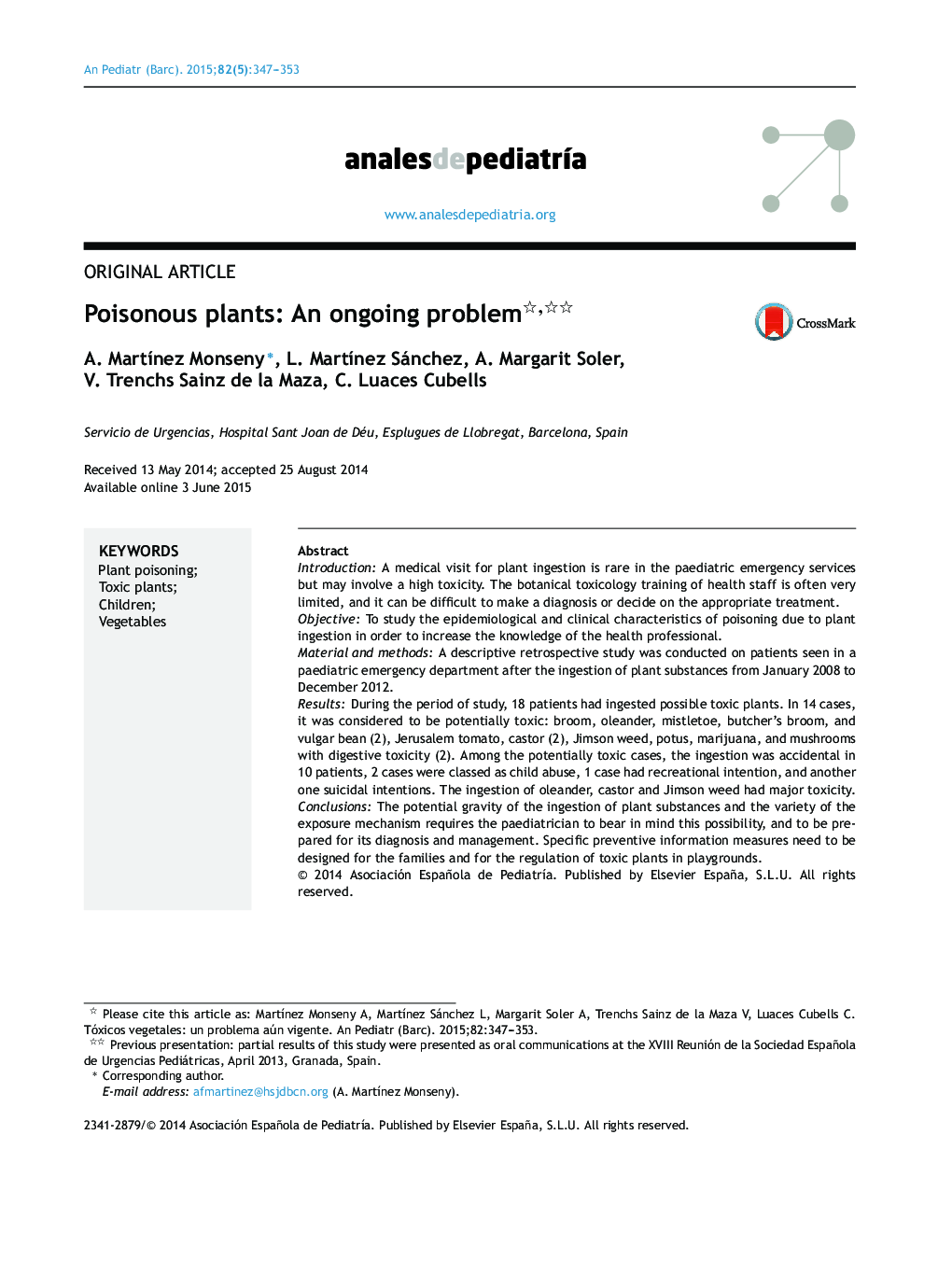| کد مقاله | کد نشریه | سال انتشار | مقاله انگلیسی | نسخه تمام متن |
|---|---|---|---|---|
| 4145266 | 1272598 | 2015 | 7 صفحه PDF | دانلود رایگان |
IntroductionA medical visit for plant ingestion is rare in the paediatric emergency services but may involve a high toxicity. The botanical toxicology training of health staff is often very limited, and it can be difficult to make a diagnosis or decide on the appropriate treatment.ObjectiveTo study the epidemiological and clinical characteristics of poisoning due to plant ingestion in order to increase the knowledge of the health professional.Material and methodsA descriptive retrospective study was conducted on patients seen in a paediatric emergency department after the ingestion of plant substances from January 2008 to December 2012.ResultsDuring the period of study, 18 patients had ingested possible toxic plants. In 14 cases, it was considered to be potentially toxic: broom, oleander, mistletoe, butcher's broom, and vulgar bean (2), Jerusalem tomato, castor (2), Jimson weed, potus, marijuana, and mushrooms with digestive toxicity (2). Among the potentially toxic cases, the ingestion was accidental in 10 patients, 2 cases were classed as child abuse, 1 case had recreational intention, and another one suicidal intentions. The ingestion of oleander, castor and Jimson weed had major toxicity.ConclusionsThe potential gravity of the ingestion of plant substances and the variety of the exposure mechanism requires the paediatrician to bear in mind this possibility, and to be prepared for its diagnosis and management. Specific preventive information measures need to be designed for the families and for the regulation of toxic plants in playgrounds.
ResumenIntroducciónLa consulta por ingesta de plantas es poco habitual en los Servicios de Urgencias pediátricas pero puede conllevar una elevada toxicidad. La formación sobre toxicología botánica del personal sanitario suele ser escasa y puede resultar difícil llegar al diagnóstico o establecer el tratamiento adecuado.ObjetivoEstudiar las características epidemiológicas y clínicas de las intoxicaciones por ingesta de sustancias vegetales con el fin de aumentar su conocimiento en el personal sanitario.Materiales y métodosEstudio descriptivo retrospectivo de los pacientes atendidos por ingesta de sustancia vegetal, entre enero del 2008 y diciembre del 2012, en el Servicio de Urgencias de un hospital materno-infantil de tercer nivel.ResultadosDurante el periodo de estudio fueron atendidos 18 pacientes con ingesta de un posible tóxico vegetal. En 14 casos la ingesta se consideró potencialmente tóxica: retama, adelfa, muérdago, acebillo, judía vulgar (2), tomate de Jerusalén, ricino (2), estramonio, potus, marihuana y setas con toxicidad digestiva (2). De estos, en 10 la ingesta fue no intencionada, 2 casos pueden enmarcarse en el maltrato infantil, se produjo un caso con fin recreativo y otro con fin suicida. Destacaron por su toxicidad las ingestas de adelfa, ricino y estramonio.ConclusionesLa potencial gravedad de la ingesta de sustancias vegetales y la variedad de los mecanismos de exposición al tóxico obligan al pediatra a tener presente esta posibilidad y estar preparado para su diagnóstico y manejo. Es necesario diseñar medidas preventivas específicas, como la información a las familias o la regulación de la presencia de plantas tóxicas en zonas de recreo.
Journal: Anales de Pediatría (English Edition) - Volume 82, Issue 5, May 2015, Pages 347–353
